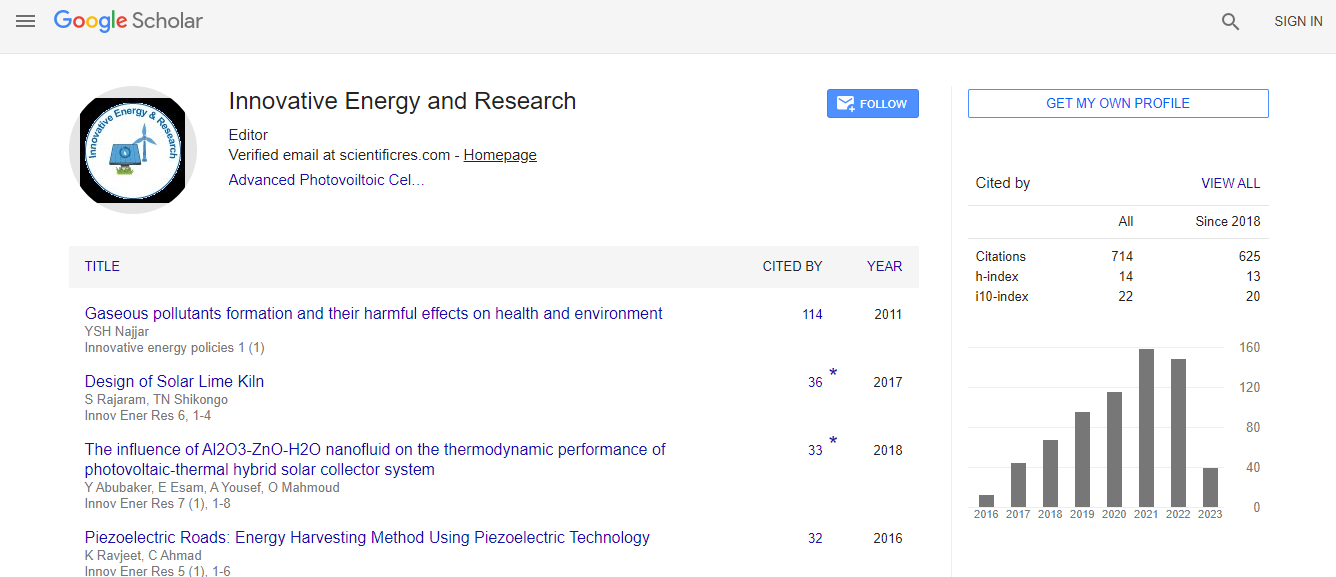Our Group organises 3000+ Global Conferenceseries Events every year across USA, Europe & Asia with support from 1000 more scientific Societies and Publishes 700+ Open Access Journals which contains over 50000 eminent personalities, reputed scientists as editorial board members.
Open Access Journals gaining more Readers and Citations
700 Journals and 15,000,000 Readers Each Journal is getting 25,000+ Readers
Google Scholar citation report
Citations : 712
Innovative Energy & Research received 712 citations as per Google Scholar report
Innovative Energy & Research peer review process verified at publons
Indexed In
- Google Scholar
- Open J Gate
- Genamics JournalSeek
- RefSeek
- Hamdard University
- EBSCO A-Z
- Publons
- Euro Pub
- ICMJE
Useful Links
Recommended Journals
Related Subjects
Share This Page
Detection and application of heavy metal ions in environment and biological cell imaging based on fluorescence probe testing technology
Joint Event on 2nd International Conference on Renewable Energy and Resources & Energy Materials and Fuel Cell Research
Gang Zhao, Gang Wei, Shanyi Guang, and Hongyao Xu
Donghua University, China
Posters & Accepted Abstracts: Innov Ener Res
Abstract
During recent decades, Fluorescence sensing using small molecule probes has been one of the most powerful and popular tools to help us monitor and visualize amounts of samples in a biological system because of their simplicity, high sensitivity, as well as excellent spatiotemporal resolution. Aluminum ion is an essential trace prevalent element, an excessive amount of aluminum in the human body could be believed to cause health issues. We reported herein the design, synthesis, and environmental, biological evaluations of a novel bipyridine fluorescence sensor is used to recognize aluminum ions, which is induced by Al3+ lead to a highly selective fluorescence “turn-on” response toward Al3+ over other metal ions with micromolar sensitivity. The 1:1 stoichiometric structure between RhBD and Al3+ were supported through Job’s plot, 1H NMR, FTIR, ESIMS. The analytical results obtained through UV-vis and fluorescence spectrophotometry display that linear range and the limit the detection (LOD) of the present sensor for Al3+ are 0.8~70 μM and 0.33×10-7 M, respectively. The present probe was used to the detection of Al3+ in drinking water with the recoveries ranging from 99.2 to 100.7%, and fluorescence imaging for living HeLa cells.Biography
Gang Zhao is a PhD candidate in the state key laboratory for modification of chemical fibers and polymer materials, college of materials science and engineering, Donghua University, Shanghai, China. Her main research direction investigated the organic-inorganic nanohybrid fluorescence chemosensor, and used to environmental and biological sample, in addition, which can trace cell morphology from time to time by a quantitative increase in the concentration of different metal ions. Has her expertise in evaluation and passion for improving the health and wellbeing. Her open and contextual evaluation model based on responsive constructivists creates new pathways for improving healthcare. She has built this model after years of experience in research, evaluation, teaching, and administration both in hospital and education institutions. The foundation is based on the fourth-generation evaluation (Guba& Lincoln, 1989) which is a methodology that utilizes the previous generations of evaluation: measurement, description, and judgment. It allows for value-pluralism. This approach is responsive to all stakeholders and has a different way of focusing.
E-mail: ganggzhao@163.com

 Spanish
Spanish  Chinese
Chinese  Russian
Russian  German
German  French
French  Japanese
Japanese  Portuguese
Portuguese  Hindi
Hindi 
